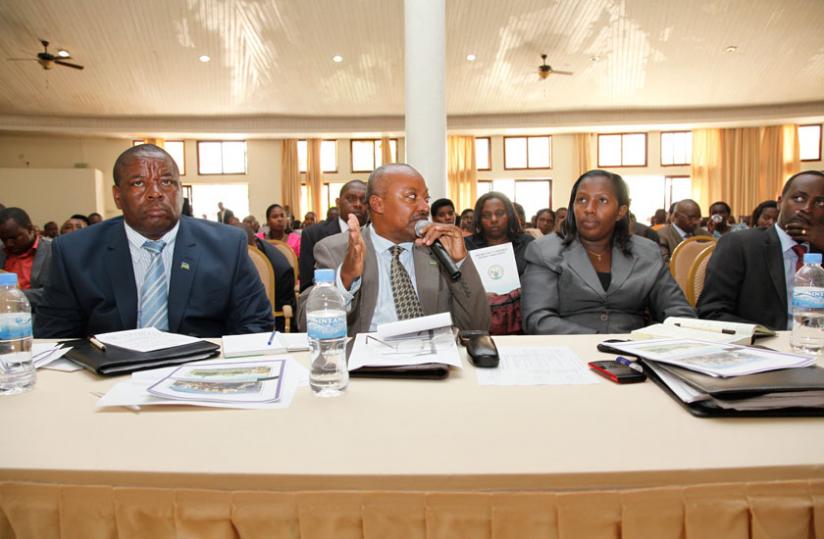When Transparency Rwanda conducted a survey on public service delivery in 2011, it found lack of staff to attend to citizen's needs at local government as one of the most common grievances reported.


When Transparency Rwanda conducted a survey on public service delivery in 2011, it found lack of staff to attend to citizen’s needs at local government as one of the most common grievances reported.
Absence of staff was and can still be attributed to spending so much time in meetings, most of which necessitated officials to travel long distances, according to the watchdog.
At least twice a month, local government leaders and their teams from far-flung districts would travel to the capital Kigali to attend planning meetings with the central government.
In the process, they would spend precious days and resources away from the constituencies they serve. Some attest that a single meeting would keep them away from their workstations for three days.
But since the introduction of videoconferencing in November, last year, provincial governors, mayors and other district heads, no longer travel to the capital for meetings, and, along with it, unnecessary expenses have been cut down.
"Service delivery usually requires physical presence, according to the watchdog, and when a leader travels far away, he or she may deny his people some services due to his absence,” Francis Umurungi, in-charge of institutional development and advocacy at Transparency Rwanda, told The New Times.
"One main reason why services are usually not delivered is because of too many meetings. They take time and resources. Video-conferencing is therefore one of those initiatives that have reduced the cost of meeting – and all the money and time that was spent can now be injected in solving citizens’ challenges.”
This new era was ushered in on October 16, 2013, when the first local government video-conferencing was conducted.
From the comfort of their offices, officials from all 30 districts flawlessly interacted with James Musoni, then the Minister for Local Government, via high resolution monitors that were installed with technology to stream live visual and audio feed.
Under the e-government programme, the service is one of the fruits of the fibre optic that has been rolled out throughout the country, enabling high-speed internet connection in all corners of the country.
"Traveling to and from a meeting in Kigali would take a single mayor close to three days, especially those from far away districts. Now all they have to do is switch on the monitor and spend three hours discussing projects,” Vincent Munyeshyaka, the Permanent Secretary at the Ministry of Local Government said in an interview last week.
"Video conferencing has tremendously reduced the cost spent discussing development issues. This time and money is now reallocated in real works that develop the nation.”
To conduct one physical meeting in Kigali, the government spent up to Rwf3 million on transport and other logistics for officials who had traveled long distances.
"We had to hire hotels for conference meetings, meals and accommodation. Now we spend zero. All the weekly, monthly and annual meetings are now attended via video conferencing,” Munyeshyaka added.
Every month, local government officials are required by law to attend at least two meetings. These are security meetings, coordination committee meetings, district council meetings or budgetary planning meetings.
For example, Protais Murayire, the Mayor of Kirehe District, far off in the Eastern Province, would travel one-way for close to three hours to attend a four-hours District Council Meeting in Kigali.
This was until videoconferencing was introduced.
"Once a meeting was called, we organized to travel as a team and spent close to Rwf100,000 on transport and logistics. On top of being costly, it was time and energy consuming. Now when a meeting is called, I alert my team and we are present, tuned in to a videoconference,” Murayire said.
According to the Justus Kangwagye, the chairperson of the Rwanda Association of Local Government Authorities (RALGA) and Mayor of Rulindo District, videoconferencing has made interaction between government officials "smarter” and reduced the strain on National Budget
"District heads now travel only when they must. With videoconferencing, their work and presence is monitored because the minister can call in for a conference anytime when a mayor is expected to be at work,” Kangwagye said.
On top of that, archiving discussions for future reference is made easier, and therefore, the element of commitment to work and accountability is often given quick video reference.
"Unless the meeting is confidential, all employees in my province can attend the meetings from within the province and discuss issues straight with the minister as they see him on TV. There is no need to repeat what was said. If we need to clarify something, we refer to the recorded video Odette Uwamariya, the Governor of Eastern Province said
"I am no longer obliged to travel to Kigali unless it is a sensitive meeting that requires physical presence. Video conferencing has brought in a level of modernity that eases interaction.
Videoconferencing by local government is supported by a 3,000 kilometre optic cable which connects 97 institutions in Kigali, 220 countrywide and all Rwanda’s borders posts
Other public services that are now powered by video link include judicial services where courtrooms have now been connected and witnesses from any part of the country can address court without necessarily having to make a long distance.


